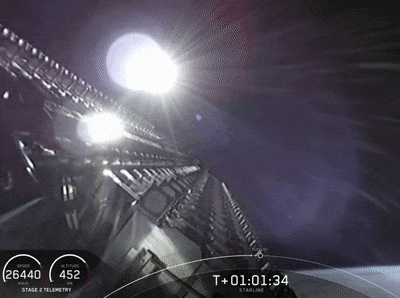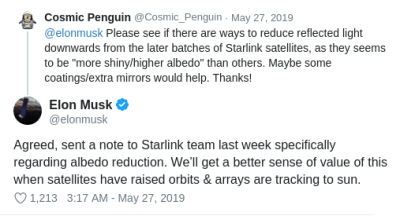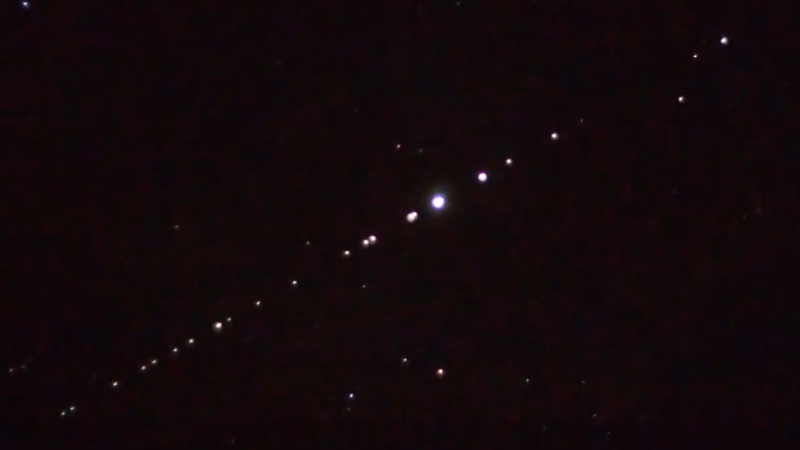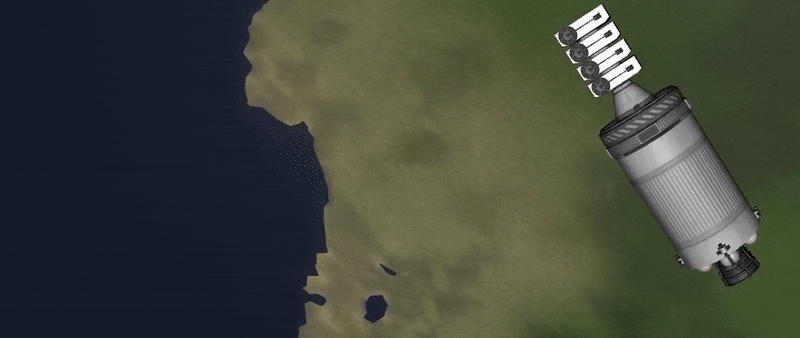Have you looked up into the night sky recently and seen a bizarre line of luminous dots? Have you noticed an uptick in the number of UFO reports mentioned in the news and social media? If so, you may have already been touched by what many have come to affectionately call Elon Musk’s “Space Train”: a line of tightly grouped Starlink satellites that are making their way around the globe.
Some have wondered what’s so unique about the Starlink satellites that allows them to be visible from the ground by the naked eye, but that’s actually nothing new. It’s all about being in the right place at the right time, for both the observer and the spacecraft in question. The trick is having the object in space catch the light from the Sun when it has, from the observer’s point of view, already set. It’s essentially the same reason the Moon shines at night, but on a far smaller scale.

The phenomena is known as “satellite flare”, and chasing them is a favorite pastime of avid sky watchers. If you know when and where to look on a clear night, you can easily spot the International Space Station as it zips across the sky thanks to this principle. NASA even offers a service which uses email or SMS to tell you when the ISS should be visible from your location.
What makes the Starlink satellites unique isn’t that we can see them from the ground, but that there’s so many of them flying in a straight line. The initial launch released 60 satellites in a far tighter formation than we’ve ever seen before; Elon even warned that collisions between the individual Starlink satellites wasn’t out of the realm of possibility. The cumulative effect of these close proximity satellite flares is a bit startling, and understandably has people concerned about what the night sky might look like when all 12,000 Starlink satellites are in orbit.
The good news is, the effect is only temporary. As the satellites spread out and begin individual maneuvers, that long line in the sky will fade away. But before Elon’s “Space Train” departs for good, let’s look at how it was created, and how you can still catch a glimpse of this unique phenomena.
Like a Deck of Cards
As a general rule, satellites are ejected from their carrier rocket with some degree of force so they’ll keep a safe distance from each other. To keep complexity down and reliability up, this mechanism in many cases is nothing more exotic than a large spring which can be released remotely. Even this slight nudge is enough to make sure the gap between the objects continues to widen, as they move through their now separate (though still very similar) orbits.
 But the Starlink launch was unique in that no powered ejection system was used. Instead, the satellites were allowed to drift away from the second stage of the Falcon 9 propelled by nothing more than simple physics. Not only was this cheaper and easier than creating an ejection system for 60 satellites, but keeping them close together at release also simplifies the orbital maneuvers necessary to move them into their final orbits.
But the Starlink launch was unique in that no powered ejection system was used. Instead, the satellites were allowed to drift away from the second stage of the Falcon 9 propelled by nothing more than simple physics. Not only was this cheaper and easier than creating an ejection system for 60 satellites, but keeping them close together at release also simplifies the orbital maneuvers necessary to move them into their final orbits.
So how was this accomplished? We can get our first clue by taking a close look at SpaceX’s live mission coverage. Before the satellites are deployed, the movement of the Sun and Earth in the background shows the second stage of the Falcon 9 was in a flat spin. If you’ve ever watched the live coverage of previous SpaceX launches, or really any launch for that matter, you’ll know how unusual this is.
Normally the launch vehicle would be stabilized so that the only momentum imparted on the payload is that of the ejection force. But here, SpaceX intentionally spun up the second stage of the vehicle so that when the satellites were released they would essentially be “thrown” by centrifugal force. Talking about the deployment in a pre-launch press conference, Elon Musk said it “will seem like spreading a deck of cards on a table.”
To help visualize this, we can recreate the deployment on a smaller scale with everyone’s favorite rocket simulator, Kerbal Space Program:
Seen from this perspective, it’s clear how the “Space Train” was initially formed by this unusual method of satellite deployment.
See Them Before They’re Gone
If that was the end of the story, we could expect to see a relatively tight line of Starlink satellites in the sky for quite some time. But these satellites have a job to do, and their own individual propulsion systems. Once the inertia imparted on them by the Falcon 9’s rotation gave them a bit of breathing room, they were able to activate their thrusters and begin making the maneuvers necessary to put them into their final orbits.
As you read this, the “Train” is breaking up. The low-thrust ion engines used by the Starlink satellites mean that their separation won’t happen overnight, but every day that passes puts more distance between this once extremely tight-knit group. Nobody outside of SpaceX knows exactly how long this process will take, but a few weeks is probably not an unreasonable estimate given the motion we’ve already seen since launch.
That means there’s still some time to see them for yourself. The website N2YO is currently tracking the mass of Starlink satellites and will generate a list of dates and times where they should be visible from your location. Keep in mind that as these satellites are actively maneuvering, the exact time they make their pass could vary slightly from these calculations. For best results, get your eyes adjusted to the dark and start start looking a few minutes before the predicted pass.
A Potentially Dimmer Future
Logically, one could assume that a similar “Space Train” should be visible for the first couple of weeks after each new batch of Starlink satellites is launched. So even if you end up missing this one due to cloud cover or the fact you don’t want to get up before dawn, there should still be literally hundreds of opportunities to do so in the next few years.
 But we already know these satellites were only a step above the prototype stage, and that SpaceX anticipates they will go through several design changes before they really start ramping up production. Elon has also commented that he’s directed the Starlink team to look at ways of reducing the reflectivity of the satellites. It’s possible that hardware tweaks to the next batch of satellites to get launched reduces or eliminates the flare effect entirely.
But we already know these satellites were only a step above the prototype stage, and that SpaceX anticipates they will go through several design changes before they really start ramping up production. Elon has also commented that he’s directed the Starlink team to look at ways of reducing the reflectivity of the satellites. It’s possible that hardware tweaks to the next batch of satellites to get launched reduces or eliminates the flare effect entirely.
Whether or not the next generations of Starlink satellites manage to eliminate the post-launch “Space Train” effect, one thing is certain: there’s no reason to worry that the night sky of the future will be criss-crossed with illuminated dotted lines. Once all of the maneuvers are complete and they’ve been deposited in their final orbits, the Starlink satellites will be no more visible in the night sky than the thousands that are already whizzing around overhead.
Images of Starlink satellites in orbit taken from a video posted to YouTube by Movie Vertigo.

















“To help visualize this, we can recreate the deployment on a smaller scale with everyone’s favorite rocket simulator, Kerbal Space Program:”
Must have taken some work…once you gotten off the ground. ;-)
I do love that Kerbal is used for this sort of thing. There were (are?) people who used to moan that the simplifications in the physics engine made it just a silly game, but it still posesses enough real physics to be fun *and* educational.
The fact it’s moddable helps a lot.
The main problem with the KSP physics engine is that it only simulates gravity for one body at a time, so for example you can’t put a station into a Lagrange point like you can in the real world. But physics when in orbit around a single moon/planet is pretty good and will definitely help you understand how it all works.
Incidentally, there are mods that make the physics more accurate if you’re into that sort of thing.
I wonder how the flat-earthers and “space ain’t possible” brigade are explaining this one?
Having a “crisscross grid” of such satellites in space would be a fun way to mock the flat-earthers :^D
Maybe have the satellites “darken” themselves via either UV paint or … something, so that the satellites are not an eye sore in the near future after rubbing facts into the flat-earthers…
Or even better, get the things to scatter in a way so they kinda write “Round earth” or something….
I’m sure Elon musk could do that as a sense of humor atop achieving great goals.
“Explain”? Haha, good one. I’ve not yet seen a flat Earth person who could explain anything.
On the contrary, they seem to be able to explain _everything_!
But surely it’s no problem for the flat earth theory that you can see upwards into the night sky from great disk of the earth. Your satellites just circle around.
(Obligatory dose of reality: you can see the curvature of the earth looking off from a not-very-high cliff over the ocean on a clear day. It’s not _even_ rocket science. Where do these people live?)
Yep, I cant believe how the internet has created these wacky conspiracy theories. The explaining everything factor sounds similar to religion’s. Actually, I think it fills a void in the religiously prone, should be classified as a mental illness! I always laugh at the idea that if somehow alien contact was made(extremely unlikely) the government would suppress it because the shock it would create to the world’s religions. BS, somehow the aliens would be incorporated into the many different religions throughout the world.
They existed far before the internet – the internet just allowed them to find each other.
It seems unlikely to me that very many people who claim to believe in a flat Earth actually do—more likely, they just want attention for being contrarians, like any other trolls.
I wonder when will astrophotography software start adding “Automatic StarLink removal” postprocessing in their toolset.
I have read that a lot of astronomers have a issues with these junk toy satellites Musk is throwing into orbit.
I just wish there was a way of collecting them and sending hutling into the Sun.
Nope. Satellites are already a thing, are super common already, and these won’t be anywhere near the brightest. ISS alone is brighter than the whole eventual constellation of 12,000 combined (assuming they ever get that far).
These satellites and others like them will serve more people than any other telecommunications constellation ever. They will address connectivity and broadband affordable access for everyone (except authoritarian regimes who want to control access). They’ll directly benefit hundreds of millions of people and indirectly benefit (through competition and increased access) billions more. They’re not “junk toy satellites.” SpaceX is already addressing the visibility issue. Operationally, these satellites will barely be visible to the naked eye in the darkest of locations. Later versions may be undetectable with the naked eye entirely.
It’s amazing, though, people (not speaking of the even-keeled astronomers who are providing useful insight) will blow anything out of proportion and insist all progress stop.
They’re bright because they’re close up. Their brightness follows the square law, and it diminishes once they raise orbit to 550 km, where they’ll appear about 1/3 as bright.
Unfortunately, SpaceX has another 7,500 Starlink satellites coming up that they’re going to leave at the low 340 km orbit for low latency, and they’re going to be a big grid of fast-moving bright spots criss-crossing the night sky.
And, the point of Starlink is to invade the developing world market before the developing countries themselves manage to build competing infrastructure, which would make SpaceX a de-facto monopoly in these areas because it would take local competition years and billions of dollars to provide equal coverage.
Why hasn’t Iridium or someone offered a low-cost low-priority plan to crack these markets? I’ve been suggesting it for years — it would increase terminal manufacturing volume and drive costs down, it would provide a cheap entry point for hobbyists to develop more products that use the service, and it would sneak data into corners of the globe where there isn’t any right now.
If Starlink is first to market with it, the incumbent constellations have only themselves to blame.
The traditional satellite internet market places the link satellites in geostationary orbit, or near-geostationary orbit, which makes the latency unbearably long and the data bandwidth rather limited. They serve a different need: low cost global satellite telephones and slow data links.
The higher up you go, the longer the latency, but the fewer satellites you need to provide continuous coverage. That’s why Starlink places the satellites on three orbital shells: 1100 km, 550 km, and 340 km.
The low 340 km orbit allows for latencies that are on-par with wired internet – but the satellites are going around so fast that any one satellite will only stick around for half an hour, so you need about 7,500 of them to form a grid that is continuously going around the earth – that puts them on a grid of about 500 km between each node, so you’re never more than couple hundred km away from a satellite.
>If Starlink is first to market with it, the incumbent constellations have only themselves to blame.
They’re not only in competition with Iridium and pals, but all the local wired and cellular ISPs because the whole point of Starlink is basically putting wi-fi routers up on low earth orbit. Some poor African country doesn’t even have a point in developing their own infrastructure, because Starlink already exists and keeps competition down by offering “charity” prices.
The result is a global network that is controlled by a single US corporation that has the power to stomp any local competitors to the ground – as long as the system works as advertised. Of course it’s still a Musk project, which means you’ve got to take it with a pound of salt anyways.
>And, the point of Starlink is to invade the developing world market before the developing countries themselves manage to build competing infrastructure, which would make SpaceX a de-facto monopoly in these areas because it would take local competition years and billions of dollars to provide equal coverage.
And if SpaceX don’t offer it?
…..
It will take local competition years and billions of dollars to provide equal coverage.
Don’t believe me? Look at the US.
And speaking of authoritarian regimes who want to control access, how would you like if your country’s biggest ISP was owned by a foreign company that answers to the NSA?
Safe, because at least it’s just the NSA not the FSB or People’s Party.
But with you it’s “perfect or useless”. To you the fact that the USA is better than any other world power doesn’t make up for the fact that they aren’t perfect.
I have owned a 6ft long by 1ft radius telescope for half of my life (just over 16 years). In all of that time using the thing I have had more clouds, birds and bugs block my view than any man made objects. Even then we’re talking distances where it’s going to be little more than a flicker that you would miss if you blinked at the right time.
Light pollution is a far worse problem than a bunch of tiny satellites.
Its amazing how many satellites are actually up. I dabble with astrophotography and Im lucky to live in a surprisingly dark sky location just 30 miles SE of Washington DC. Using just a mirrorless cam and 20-30 sec exposures. 9 out of 10 times I will see several streaks caused by satellites. Can even see what look like dashes – – – – – caused by tumbling defunct satellites or spent upper stages. Anyway, if this constellation actually is deployed as planned Starlink removal processing will be a must. Lol!
I don’t know what you’re seeing, but those absolutely are not satellites.
In any way.
You’re obviously not an astrophotographer.
“””The cumulative effect of these close proximity satellite flares is a bit startling, and understandably has people concerned about what the night sky might look like when all 12,000 Starlink satellites are in orbit.”””
Concerned?
The art of understatement!
I would not trust a single word out of Musk’s mouth on this nor his cronies at SpaceX on this subject because they have every reason to lie.
People would go nuts if Musk and his crazed nerds at SpaceX ended up killing astronomy and night viewing of the heavens with his light pollution sats.
Now all we nned a Earth based asat weapon to vaporize them. It’s not like they are vital to anything other than Musks massive ego.
I smell a telecom shill…
Many people have already gone nuts, I don’t think Musk will add much to that problem.
I dub thee ‘Foamy.’
Exactly! Some people are panicked
It’s completely illogical and more than a little self centered but they’re still panicking
Some people worry about aliens invading, right?
If I squint when I read “Starlink” I see “Edsel”.
Oh, wait—that was a different Elon Musk joke.
Dunno what the point of comment review is if idiocy like ^ that is accepted.
Just admit that you didn’t get the Tesla joke.
Is there a container in which the 15 TON of starlink traveled? Is the structure still orbiting the earth? any means to track it?